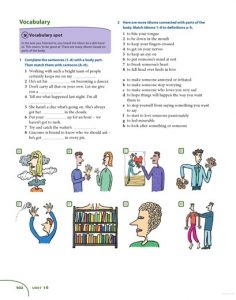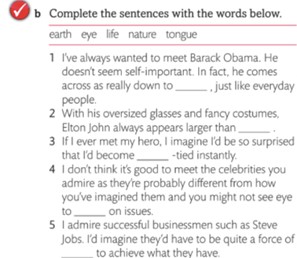**For footnotes, please view the PDF.
Abstract
This paper focuses on the problems that learners and teachers both face with idiom usage. The original submission was in part of the author’s Cambridge Diploma in Teaching English to Speakers of Other Languages Learning Skills Assignment for which it received a Merit, but it has been modified to serve a general teacher audience. This essay examines examples from several advanced level coursebooks and draws on the author’s personal experience of teaching multi-lingual classes in Canada and England, as well as exam-preparation courses in Italy to assess the value of teaching learners’ idioms. By identifying the problems that learners have with idiomatic language and analyzing different methods to help circumvent them, advanced students may be able to coherently and confidently express themselves in real-life scenarios.
Learners at an advanced level of English have the capacity to acquire idioms into their personal lexicon. However, they soon realize that learning these is not always a piece of cake. Idioms are not often included in syllabi, whether due to time or coursebook constraints. However, higher-level students enjoy the challenge of learning them in attempt to sound more like a native English speaker.
Let’s get the ball rolling: Introduction to idioms
Analyzing idioms is inherently complex based on this vagueness of the term or phrase. In essence, an idiom can be defined as a lexical item where “the meaning of the whole is not immediately apparent from the meanings of the constituent parts” (Lewis, 1993, p. 98). In fact, idioms often consist of common well-known lexis, which are assigned non-literal meaning. They are primarily used informally, when speakers “comment on themselves, other people and situations” (McCarthy & O’Dell, 2010, pp. 6–7).
Several advanced coursebooks present idioms categorically by their constituents, containing body parts as the predominant lexical set (Figures 1-3). By arranging them in this manner, the idioms seem accessible to learners who are already familiar with this everyday vocabulary. Despite this organization, the majority of these phrases may be used functionally to enhance personal descriptions or relationships. Accordingly, idioms provide a higher level of lexical sophistication for advanced students (Lewis, 1993, p. 98). For instance, I don’t see eye to eye with you means I don’t agree with you.
Figure 1.

Figure 2.

Figure 3.

Students learn phrases to disagree at an elementary level, but the use of the idiom see eye to eye enriches the concept linguistically. In this way, idioms provide advanced learners with a new means to express familiar situations.
Furthermore, idioms vary by how easily their meaning can be guessed. Moon (1997, p. 44) categorizes idioms by their non-composability, which is the ability to interpret them based on individual words. An idiom rating high in this category means that it is difficult to deduce its meaning, whereas having low non-composability could garner some guesses.
Non-composability
Low —————————————————————————————————————————————————————————High
| She stabbed me in the back when she started dating my ex-boyfriend.
· The meaning of betrayal can be inferred by the literal meaning of assaulting a person in a place where they can not anticipate it. |
You’ve got to be joking! Stop pulling my leg!
· It is hard to deduce that this expression means to trick someone based on the individual meaning of the content words, pull and leg. |
Idioms are multi-word units composed of various parts of speech. Accordingly, they come in an assortment of forms. Inversely, Lewis (2002, p. 38) believes that fixed expressions such as these should be acquired without internally analyzing them. However, there is value in dissecting idioms to their single parts in order to determine their flexibility. The extent to which it is sequentially frozen can help classify an idiom (Moon, 1997, p. 44). Changing the nouns, adjectives, articles, or prepositions would make them nonsensical because they rely on each other to convey meaning. Despite this, Lewis (2002, p. 219) defines semi-fixed expressions as those who can change an item with the same linguistic characteristics, such as possessive adjectives and objects, which reflects the perspective of the phrase without affecting the core sense.
In the flow of speech, content words with semantic meaning are typically stressed whereas those without are not (Barrera-Pardo, 2008, p. 15). Given this, function words are often reduced to weak forms: I don’t see eye to eye with you.
However, as a result of the broad categories of idioms, there are varying pronunciation patterns. Moon (1997, p. 44) defines a “phonological criterion where multi-word items often form single tone units”. In this way, each idiom has its own pronunciation pattern that must be memorized to sound natural.
The crux of the matter: Learner problems
Learners struggle with the non-literal meaning of idioms. Students who rely on bottom-up processing techniques will try to understand each word to grasp the overall meaning. While this occasionally may work for idioms that rank low in non-composability, it is more difficult for those with a higher score in this attribute. Likewise, when encountering an idiom receptively through listening, learners may not catch the unstressed counterparts in an idiom, making it challenging to deduce meaning of the whole without catching all respective parts.
Moreover, “many idioms carry subtle nuances in meaning” which challenge students (Hedge, 2000, p. 114). For example, the low non-composability of the idiom, the icing on the cake, allows students to infer that what is being described is something positive, just as the finishing touches on the dessert would be. Though it does technically mean the enhancement of an already good situation, native English speakers tend to use it in a sarcastic or ironic sentiment.
Furthermore, the duality of this idiom is played up in the title, highlighting the vagueness of language that English language learners ultimately miss out on. Advanced learners who are trying to assimilate into an ESL environment may face inaccessibility if they are unaware of these, and as a result, may feel like outcasts. Similarly, over-inserting idioms into daily speech may further out them as foreigners. Though advanced students enjoy learning idiomatic expressions in an attempt to sound more like native English speakers, this eagerness can result in their overuse in speaking and writing. Students who speak West African languages are influenced by their L1’s “rich in proverbs and colourful sayings” when speaking in L2, making them sound parodic instead of natural (Swan & Smith, 2001, p. 259). Furthermore, from my teaching experience in English for Academic Purpose classes, these students, among others, tend to insert these expressions in their essays. This proved to be problematic as many idiomatic expressions are informal and unsuitable for academic registers.
Moreover, learners inaccurately produce idioms by making errors pertaining to their rigidness. Confusing the article in a completely fixed expression such as letting the cat out of a bag renders the idiom incomprehensible (O’Dell, 1997, pp. 274–275). Changing the definite article, the, to the indefinite article, a, gives this phrase the literal meaning of freeing one’s feline, which native English speakers would find laughable. Making an error like this could be detrimental to the confidence levels of shy learners, particularly those from Japanese or Korean cultures who fear being ashamed or humiliated in front of others (Swan and Smith, 2001, pp. 309 & 241). This could result in reluctance to using idioms in the future.
Additionally, students may make a mistake with a particular word as a result of L1 interference. Italian learners may say something is as good as bread when gold is the correct English word. Conversely, Turkish speakers may assume that English’s written all over one’s face is equivalent to their expression written on one’s forehead. However, the latter is about one’s future being preconceived, similar to English’s being written in the stars, rather than the former to convey an opinion physically with one’s face. This poses complications in multilingual classrooms as learners from differing L1s may be exposed to incorrect idioms and begin producing them.
Students may also experience frustration with the correct articulation of an idiom. Learners may not be able to give accurate stress to an idiom if they have not been exposed to a model of pronunciation which highlights its stress pattern. In my experience preparing students for the Certificate in Advanced English (CAE) exam, a candidate used, Should I get the ball rolling?, to begin her collaborative task, stressing each individual word. By focusing on the accuracy of this idiom’s form, rather than ensuring the function words were unstressed, she sounded unnatural, thus weakening her attempt to use an idiom correctly.
A thorny issue: Teacher problems
Nevertheless, it is not just students who experience uneasiness with idioms. The presentation of idioms in advanced coursebooks is often unsatisfactory. Teaching idioms notionally by associating them around familiar vocabulary words will confuse learners (Thornbury, 2002, p. 127). Figure 1 presents the idioms with body parts but used in isolated examples. Learners are not given enough context on when to use the idiomatic language that would allow them to practically acquire them into their personal lexicons. By relying solely on textbook content for idioms, learners risk sounding inauthentic both in meaning and in pronunciation.
Conversely, teachers tend to shy away from teaching idioms because they date and vary regionally (O’Dell, 1997, p. 274). As a speaker of Canadian English, I personally struggled to understand some idioms presented in advanced British coursebooks just as my learners did while I was teaching abroad. For instance, being unacquainted with the phrase, I was unable to determine the meaning of on tenterhooks from context during a listening track. Though I encourage my students to receptively acquire idioms, a current coursebook presenting outdated ones is problematic for students who may try to use them productively and then be misunderstood by native speakers.
The light at the end of the tunnel: Viable solutions
Advanced learners would greatly benefit from learning idioms receptively. Doing so would present a situational context in which they are used in real-life rather than how a coursebook may present them categorically by their common lexis. This will also raise students’ awareness on when and how frequent idioms can be used naturally.
Songs are also an excellent resource to help clarify learners’ problems with meaning, form, and pronunciation. Using a gap-fill with target idioms missing that students have to listen for would greatly focus the students’ attention. In this way, they are simultaneously exposed to correct form and accurate models of pronunciation by the singer, before analyzing the lyrics in order to deduce meaning from context. Learners with musical intelligence may appreciate this variation best as it allows them to recognize the significance of the rhythmic nature of the idioms. Moreover, teens and young adults may appreciate using songs in a lesson because it makes them more accessible outside the classroom. While extroverted students will also enjoy singing along, allowing them to practice the idiomatic tone units, more introverted students would benefit from repeating the song’s idioms in isolation. Learners “can be encouraged to pronounce such phrases as quickly as possible, running the elements together” (Willis, 2003, p. 160). In this way, students practice the stressed and unstressed patterns of idioms merging into a single tone unit to sound more natural.
Having students write their own dialogues with idioms can help reinforce meaning while practicing form. Doing this in pairs will allow students to use L2 collaboratively to negotiate meaning of how and what to include in their text. In order to prevent the issue of overuse, a teacher should restrict the idiom usage depending on the length of the dialogue. Moreover, students could create a controlled practice with their dialogues by leaving a gap where an idiom should be and having another group solve it. For stronger students, they could be given an idiom to use in an improvised role-play, in which they have to insert it into the conversation naturally.
Using a thematically-relevant idiom as a class warmer and challenging students to use it throughout the lesson gives them the opportunity to produce it in conducive context. Not only does this activity build learner autonomy, as it is on the onus of the student to actively think of opportunities to use the idiom appropriately, but it also increases their incentive to participate in class. I have found this to be particularly effective in classes of advanced teenagers, who were driven to be the first to use it correctly.
As an extension, setting the task of finding an idiom a week from an outside source could be an ongoing homework task. This extension works best with advanced exam-preparation students, who begin to actively search for idioms in media, or through interaction with English speakers in ESL environments, ultimately helping them with both usage and with accurate syllable stress in their speaking test practice. Students can also share their findings with their peers. In monolingual classrooms, collaboratively discussing and comparing similar expressions in L1 helps attach new form to a familiar concept, proving to be an asset in making them more memorable.
In a nutshell: Conclusion
To sum up, advanced learners benefit greatly moving from recognition to production when it comes to idioms. Teachers must direct students towards those with social and temporal relevance and tailor their exposure to students’ learning styles in order to maximize their chances of using them accurately. Doing so will help learners combat their issues of not knowing where, when, how, and how often to use them. Taking these recommendations into account will make advanced learners feel more confident when expressing their ideas with idiomatic language to both native speakers and other learners.
References
Aish, F., Tomlinson, J. & Bell, J. (2017). Expert IELTS 7.5 coursebook. Essex, England: Pearson Longman.
Barrera-Pardo, D. (2008). The reality of stress-timing. ELT Journal, 62(1), 11–17.
Brook-Hart, G. & Haines, S. (2015). Complete advanced. 2nd ed. Cambridge: Cambridge University Press.
Burgess, S. & Thomas, A. (2015). Gold advanced. Essex, England: Pearson Education.
Hedge, T. (2000) Teaching and learning in the language classroom, Oxford: Oxford University Press.
Lewis, M. (1993). The lexical approach. England: Language Teaching Publications.
Lewis, M. (2002). Implementing the lexical approach. Boston: Thomson.
McCarthy, M. & O’Dell, F. (2010). English idioms in use: Advanced. Cambridge: Cambridge University Press.
Merriam-Webster.com. (2019). On tenterhooks. In Merriam-Webster.com dictionary. Retrieved March 23, 2019, from https://www.merriam-webster.com/words-at-play/on-tenterhooks-origin-meaning-phrase
Moon, R. (1997). 1.3 Vocabulary connections: Multi-word items in English. In N. Schmitt & M. McCarthy (Eds.), Vocabulary (pp. 43–58). Cambridge, UK: Cambridge University Press.
Norris, R. & French, A. (2014). Ready for advanced. 3rd ed. London: Macmillan Education.
O’Dell, F. (1997). 3.2. Incorporating vocabulary into the syllabus. In N. Schmitt & M. McCarthy, (Eds.), Vocabulary (pp. 274–275). Cambridge, UK: Cambridge University Press.
O’Dell, F. & Broadhead, A. (2014). Objective Advanced. 4th ed. Cambridge: Cambridge University Press.
Oxford Learner’s Dictionaries. (2019). Tenterhooks noun. In Oxford Learner’s Dictionaries. Retrieved March 23, 2019, from https://www.oxfordlearnersdictionaries.com/definition/english/tenterhooks
Powter, D. (2005) Bad Day. AZLyrics. https://www.azlyrics.com/lyrics/danielpowter/badday.html
Swan, M. & Smith, B. (2001). Learner English. Cambridge, England: Cambridge University Press.
Thornbury, S. (2002). How to teach vocabulary. Essex: Pearson Education Limited.
Willis, D. (2003). Rules, patterns and words. Cambridge: Cambridge University Press.
Author Bio.
Celine began her ESL career in Canada before combining her passion for educating others with her desire to travel abroad. While hopping around Europe, teaching in southern Italy and in England, she completed her Cambridge DELTA, earning a Merit in Modules 1 and 2. She ultimately returned to Toronto, where she teaches ESL in a private language school and develops curriculum and content for various international education companies.
